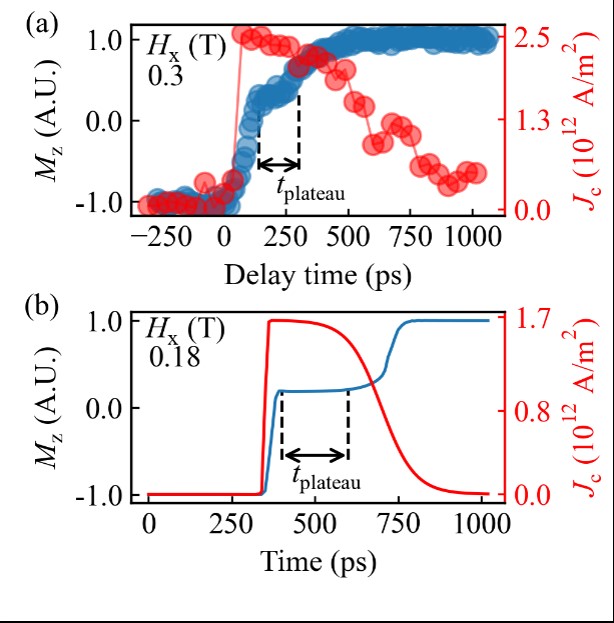SNU 10-10 Project Young Scientist Seminar(Shin Jiho)
Direct Observation of Plateau Formation in Ultrafast Spin-Orbit-Torque Driven Magnetization switching
Abstract
Current-driven magnetization switching via spin-orbit torque (SOT) has attracted significant attention as a key mechanism for next-generation spintronics devices [1-2]. SOT-induced switching is characterized by an instantaneous response due to the perpendicular alignment of the initial magnetization with the injected spin direction. This configuration maximizes spin torque, providing a significant advantage for high-speed device operation.
However, a notable aspect of SOT switching is the appearance of a plateau in the magnetization trajectory. This plateau occurs when the magnetization aligns with the injected spin direction, leading to a temporary pause in further magnetization changes. The magnetization can only escape from the plateau once the current pulse ends. Therefore, the formation of the plateau delays the overall switching process, which is disadvantageous for SOT-based device development. Consequently, understanding the factors that govern the formation and duration of the plateau remains a critical research challenge.
In this study, we experimentally observed the plateau phenomenon using a time-resolved magneto-optic Kerr effect (tr-MOKE) setup with a pump-probe technique [3-4]. We used a femtosecond laser and a photoconductive switch to generate a fast-current pulse with a sub-nanosecond pulse width, which was used as the pump. The probe was employed in a polar MOKE setup to measure the magnetization changes. Through these measurements, as shown in Fig 1 (a), we confirmed the presence of a plateau in the $M_z$ variation under specific current density and external magnetic field. The plateau emerged after the peak of the current pulse and was observed after the magnetization crossed the $xy$-plane, stabilizing at a specific point.
Micromagnetic simulations using MUMAX yielded results consistent with the experiments, as shown in Fig 1(b) [5]. Through the simulations, we investigated how the duration of they are affected by external magnetic field strength and current density. The simulations revealed that decreases with increasing external magnetic field and decreasing current density. Importantly, under certain conditions, the plateau effect was minimized, enabling ultrafast switching ($\approx 100 \mathrm {ps}$).
This work highlights the importance of understanding the plateau phenomenon for optimizing SOT-based devices. By tuning the external magnetic field and current density, it is possible to achieve high-speed switching.

Figure 1. (a) Time-resolved measurement of the M_z component (blue) and current profile (red) with respect to the delay time. The plateau (t_\mathrm{plateau}) is indicated by the dashed lines. (b) Micromagnetic simulation results showing the M_z component of magnetization (blue) and current profile (red) as a function of time. The (t_\mathrm{plateau}) is indicated.
Reference
- Miron, I., Garello, K., Gaudin, G. et al. Nature 476, 189–193 (2011).
- Luqiao Liu et al. Science 336, 555–558 (2012).
- Jhuria, K., Hohlfeld, J., Pattabi, A. et al., Nat. Electron 3, 680–686 (2020).
- Young-Gwan Choi, Gyung-Min Choi, Appl. Phys. Lett. 12 July 2021; 119 (2): 022404.
- Arne Vansteenkiste, Jonathan Leliaert, Mykola Dvornik, Mathias Helsen, Felipe Garcia-Sanchez, Bartel Van Waeyenberge, AIP Advances 1 October 2014; 4 (10): 107133.

